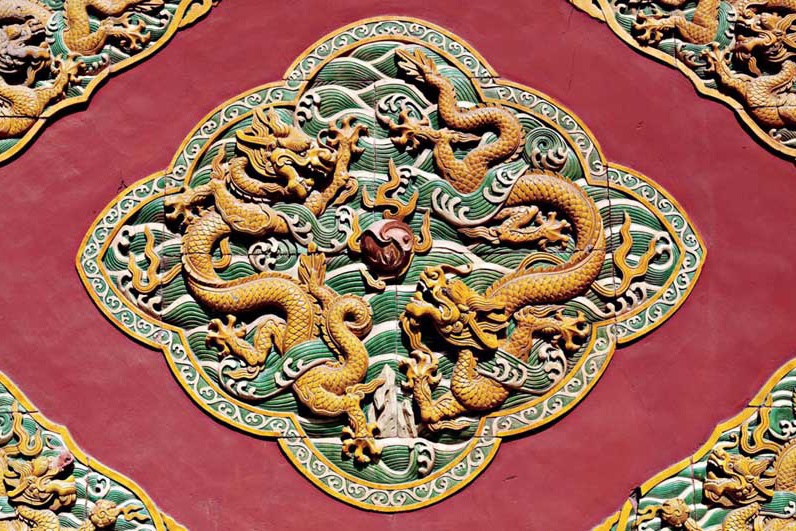
China is reputed to be the “home of dragons”. As a kind of ancient totem, dragon is a spirit animal combined of nine animal characteristics such as the body of a snake, the antlers of a deer and the ears of an ox.
From the Neolithic Age in 7,000 years ago to today’s 21st century, dragon is almost throughout the entire cultural journey of Chinese people which is long and complicated. Distinct from Western dragons with their bat-like wings which look like giant lizard and stand for evil and wars, Eastern dragons symbolize power, luck, nobility and wisdom and kindness.
In traditional Chinese culture, dragons have superpower, can live in both the heavens and on earth and are able to make countless metamorphoses. Dragons are reputed to be one of the four auspicious mythical animals together with white tiger, rosefinch and black tortoise. Chinese people usually associate dragons with water and believe dragons can bring droughts to an end with heavy rain, alleviate the hardships of the populace and bring prosperity to the land. For these reasons, there are lots of sacrificial rituals of praying for rain associated with dragons such as dragon-boat racing and the dragon dance.
Dragon-boat racing is an important and popular activity for Chinese people to celebrate the Dragon Boat Festival. It originates from rituals of worshipping the water god and was later associated with famous people of history such as Qu Yuan, finally becoming a characteristic activity in the Dragon Boat Festival. The dragon dance can be traced back to early times and there are many historical records. In the Han Dynasty, over 2,000 years ago, literature revealed that people wore colorful clothing, performed dance with cloth-made dragon in varied poses, beat gongs and drums and set off fire crackers and firework, which resembled dragons speeding across the sky and pouring out rain.
Little by little, the dragon dance has been transformed from a single ritual of praying for rain to one that prays for a long life and a good year and expresses best wishes, which has been passed from generation to generation. At the beginning of a new year, people often perform the dragon dance to celebrate the festival. The dragon dance team is often invited to perform at large-scale activities to warm the festal moon. Even when a new store is open, the dragon and lion dance will be performed to create an auspicious and fortuitous atmosphere.
Dragon is the No.1 thing signifying masculinity and is worshiped by the populace. Additionally, people usually associate dragons with imperial power. For instance, the emperor’s body was called the “dragon’s body”, the emperor’s face was called the “dragon’s face”, the emperor’s clothing was called the “dragon’s robes”, the emperor’s throne was called the “dragon’s throne” and the emperor’s descendants were called the “descendants of the dragon”. Images of dragons can often be found in architecture, sculpture and paintings.
On the ornamental columns in front of the Tian’anmen Gate in Beijing, a vivid giant dragon spiraling upward in the clouds were carved with full relief, low relief, high relief, and other carving techniques. In Beihai Park, there is a golden and magnificent Nine-Dragon Wall put together with rectangular color-glazed bricks. On both sides of the wall, there are nine dragons, with some flying up to the sky and some diving down to the sea. Besides, there are all together over 600 dragons, big or small, on the wall, and dragons can even be found at the edge and on eave tiles of the wall.
People believe that dragons can swim in the water like fish, soar in the sky like birds, control wind, rain, thunder and lightening and transform into other animals and human beings, and that they symbolize mystical powers, transformation and wisdom. As a spiritual symbol, dragon is endowed with all kind of superpower and best wishes. As a Chinese symbol, dragons have flied to all corners of the earth as ambassadors of friendship. It is worth mentioning that the Changxing 100-leaf-dragon dance, which is listed in the first batch of intangible Chinese cultural heritages, was performed on the 60th Anniversary of the Foundation of the People’s Republic of China in China and in countries such as Korea and France. It deeply impressed 120,000 audiences for three days in performances at the New Zealand Auckland Chinese New Year Lantern Festival and was a huge hit in Nice, France, where it was performed to the accompaniment of rock music.
“Dragon King Mountain” and “Dragon Lake” are common place names in China. Additionally, Chinese people are accustomed to using the Chinese character for “dragon”, or “long” in Chinese, in their names, such as Kung Fu stars Bruce Lee (Li Xiaolong) and Jackie Chan (Cheng Long), who have gained widespread popularity among both Chinese and Western audiences. It is well-known that there are many idioms associated with dragons such as “bring a picture of a dragon to life by putting in the pupils of its eyes” (huà lóng diǎn jīng), “to pretend to be fond of something which one actually fears” (yè gōng hào lóng), “full of vigor and vitality” (shēng lóng huó hǔ) and “to have high expectations of one’s children” (wàng zǐchéng lóng).
In a word, dragons can be found everywhere in Chinese daily life and is widely favored by Chinese people. In legends, stories and drama, dragons usually play a positive leading role, with the exception of a few negative dragon characters, and images of dragons can be found on apparel and bags. Even some famous overseas watch brands have incorporated the image of dragon into their product designs. For thousands of years, there has been a marked change in the image of dragons. Nowadays, cute images of cartoon dragons are very popular, which lies in sharp contrast to the more traditional dignified and awe-inspiring images of dragons.



